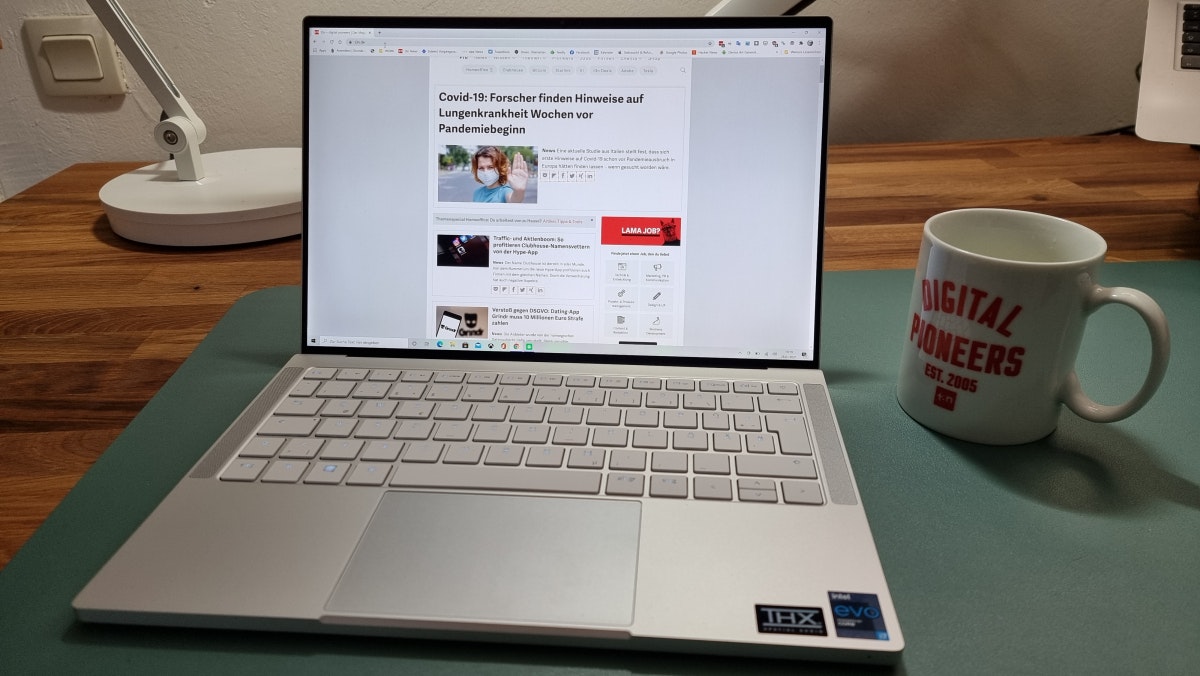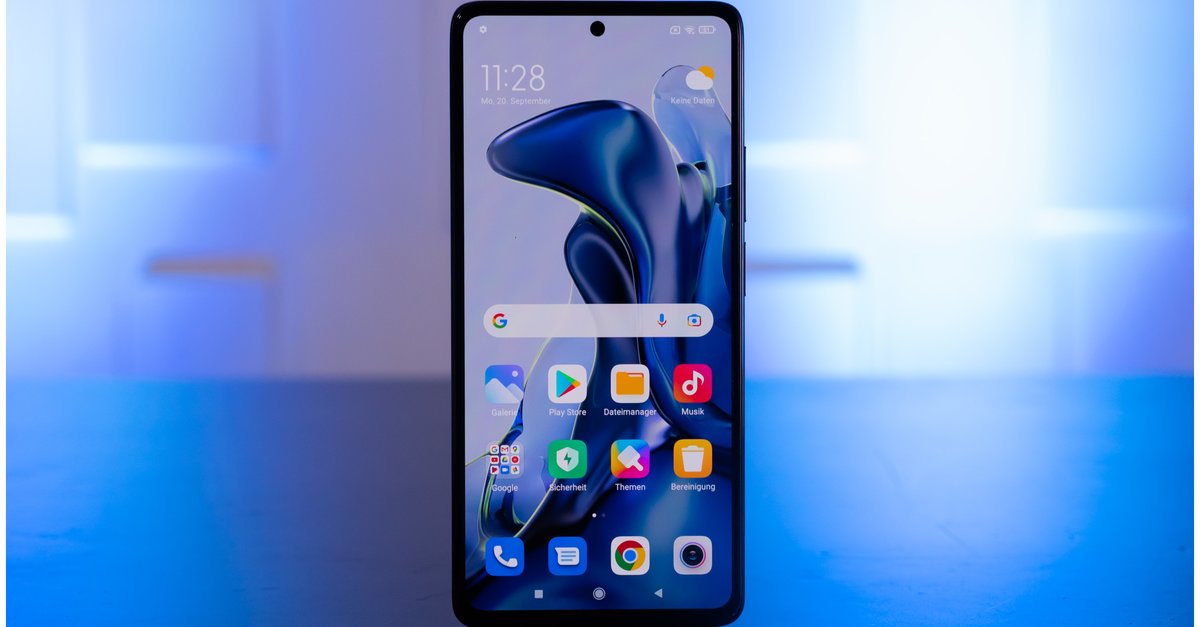Razer Book 13 in the test: by gamers, for the office
No time right now?
Note: We have used commission links in this article and marked them with “*”. If an order is placed via these links, t3n.de receives a commission.
Get out of the gamer’s corner: Razer’s Book 13 is the first notebook from the US gaming specialist for the (home) office. The 13-inch ultrabook doesn’t have to hide behind Dell’s XPS 13 – we tried it out.
Razer is primarily known for its gaming products, but the US manufacturer has also been poaching in office waters for a few months. Starting with the keyboard-mouse combo Pro Click and Pro Type, the manufacturer followed up with the Razer Book 13 in November. The 13.4-inch notebook is roughly based on Razer’s Blade Stealth, which came along without a dedicated graphics unit and in a simple matt black. The aluminum case of the Book 13, which is just as simple in silver, should fit even more into business life, although Razer couldn’t completely do without little gimmicks in its pure business notebook.
Contents
Razer Book 13: well processed – more connections than hip
Razer’s first business notebook is excellently built and, with its dimensions of 295.6 x 198.5 x 15.15 millimeters, is extremely compact. For comparison: Dell’s equally compact XPS 13 measures 295.7 x 198.7 x 14.8 millimeters and weighs only 100 grams less than the Book 13 at 1.3 kilograms.
Razer Book 13. (Photo: t3n)
Razer was able to achieve the narrow design mainly through narrow display bezels on all four sides. Nevertheless, the 720p webcam sits above the screen and not, as in Huawei’s Matebook X Pro, in the keyboard, which creates a higher level of privacy, but also an unsightly frog’s-eye perspective.
Visually, the Razer 13 is reminiscent of a modernized version of Apple with its slightly angular frame, the speaker openings on the left and right of the white keyboard, which are protected by finely perforated metal rails Powerbook G4 from 2003. There is no apple logo on the back of the display lid, but a Razer logo discreetly set off in shiny silver: the three-headed snake.

Razer Book 13 from behind. (Photo: t3n)
The Razer Book 13 has a relatively large number of connections for current ultrabooks compared to models from the competition: Apart from two USB-C ports with Thunderbolt 4, which can be found on the left and right of the case, the notebook also has one on the right Full size HDMI 2.0 port and left via a USB Type A port (USB 3.1 Gen 1). Another welcome feature is the micro SD card reader. Thanks to the numerous ports, owners of the laptop do not necessarily have to carry around a dongle.
Razer Book 13: Bright IPS display, narrow bezels
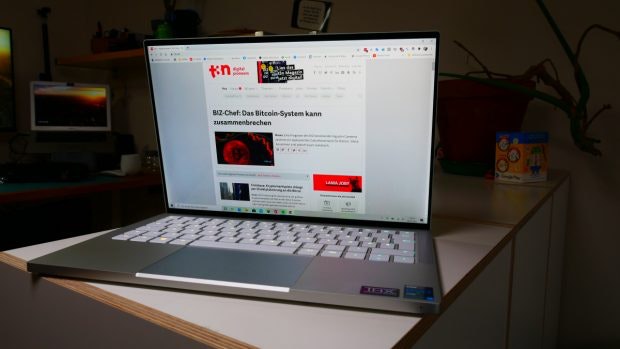
The display of the Razer Book 13 is nice and bright and is offered in Full HD or 4K resolution, depending on the version. (Photo: t3n)
In addition to the compact design and the relatively large number of connections, the Razer Book 13 also scores with its excellent bright display. It has a diagonal of 13.4 inches and a 16:10 aspect ratio, which is ideal for office use. Razer offers its Book 13 optionally with full HD resolution with or without a touch screen or with a UHD touch screen. We were given the model with UHD resolution of 3,840 x 2,400 pixels, which, thanks to its high maximum brightness, can also be read quite well in sunlight despite its slightly shiny screen.
The screen is also viewing angle stable and supports viewing angles of up to 178 degrees. Furthermore, the screen is connected to the housing with a hinge, which, like Asus’ Ergolift, lifts it into a slightly ergonomic position and at the same time ensures better ventilation from below.
Razer Book 13 keyboard and trackpad
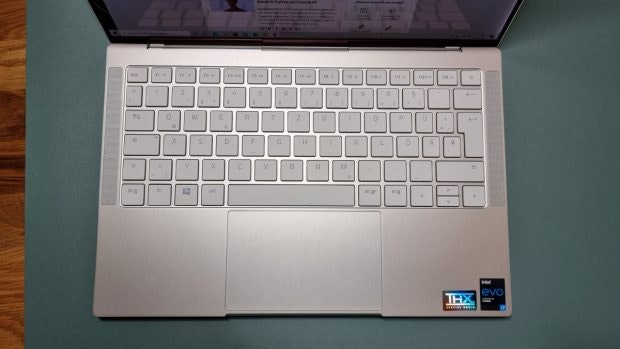
The keyboard with RGB lighting of the Razer Book 13. (Photo: t3n)
The fact that Razer has its origins in the gaming world is particularly evident in the Book 13’s keyboard, whose individual keys have RGB backlighting. Especially when you switch on the keys for the first time, they waft in many bright colors. With the pre-installed Razer Synapse application, you can adjust the keyboard key animation as you wish using the Chroma Studio settings and, if necessary, simply add a classic white backlight. However, the RGB keys are not evenly illuminated, that is better.
The keyboard itself has large keys that have a soft pressure point and a relatively short travel. After a short period of getting used to it, you get along well with it, although a slightly better defined pressure point would be desirable. After all, it is extremely quiet, even longer writing is no problem. We like the keyboard of the Surface Laptop 3 (test) better in terms of typing comfort.
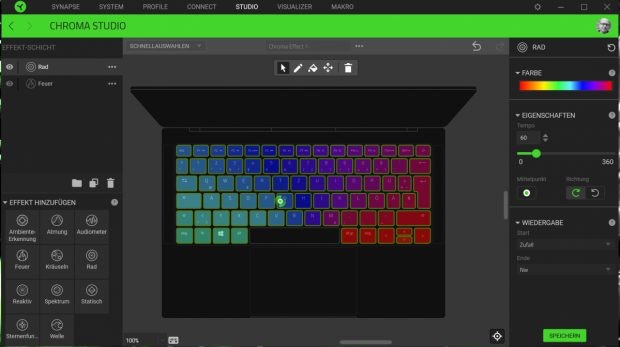
You can’t do without elements from the gaming world: The RGB keyboard of the Razer Book 13 can be provided with colors and animations. (Screenshot: Chroma Studio / t3n)
Razer has done everything right with the trackpad: It is extremely large for a Windows notebook and thanks to Microsoft’s Precision drivers it works exactly on every input.
Razer Book 13: Performance and Runtime
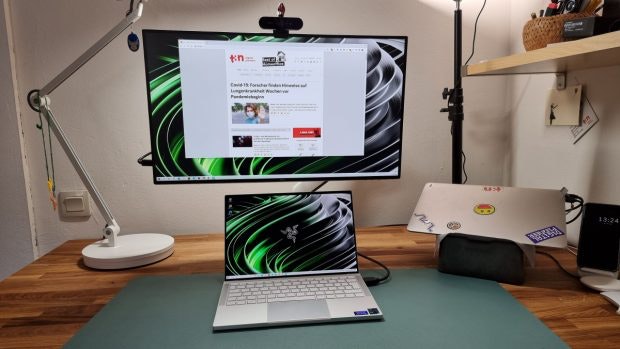
Razer Book 13 on the external display via HDMI port. (Photo: t3n)
The Razer Book 13 is available in three different versions: The entry-level model with Full HD without touchscreen has an Intel Tiger Lake Core i5-1135G7 (max. 3.8 gigahertz) with eight gigabytes of RAM and 256 gigabytes of SSD storage; it costs 1,299 euros. The middle model at a price of almost 1,700 euros has a full HD touch display, Intel Core i7-1165G7 (max. 4.7 gigahertz), 16 gigabytes of RAM and a 256 gigabyte SSD. The most expensive Razer Book 13 has a 4K touch display, the same Intel chip as the middle Book and 512 gigabytes of SSD storage – the main memory is 16 gigabytes. The price is just under 2,000 euros.
Equipment options of the Razer Book 13:
- Intel Core i5 (1135G7); FHD non-touch; 8 GB of RAM; 256 GB SSD; Windows 10 Home – 1,299 euros *
- Intel Core i7 (1165G7); FHD touch; 16 GB RAM; 256 GB SSD; Windows 10 Home – 1,699 euros *
- Intel Core i7 (1165G7); 4K touch; 16 GB RAM; 512 GB SSD; Windows 10 Home – 1,999 euros *
Our test device is the most expensive version that we wouldn’t necessarily go for if we bought it. From our point of view, the medium version offers the better price-performance ratio, although we would prefer the model with a 512 gigabyte SSD. The available capacities are also sufficient for the office.
In terms of performance, the Razer Books 13 delivers well with its new 11th generation Intel processors in combination with 16 gigabytes of RAM. Working with Office applications is also possible without any problems with larger files. Even older games run without complaints thanks to the Intel Xe graphics unit with medium graphics resolution. The built-in SSD is not a bottleneck either and delivers good rates. If the SSD is not enough, it can be exchanged; The RAM is firmly soldered and cannot be expanded, which is why you should consider whether you need 8 or 16 gigabytes before buying.
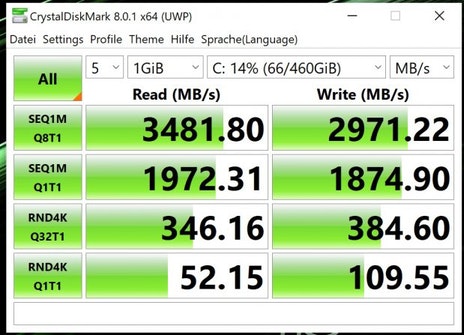
The SSD in the Razer Book 13 delivers good rates. (Screenshot: t3n)
As with other notebooks, the battery life of the Book 13 with its 55 watt hour battery depends on the usage scenario. The battery is sufficient for an eight-hour day in medium brightness and usual office applications. The more intensively you use the computer, the faster the notebook calls for a power supply. The runtime should be better with the Full HD version – a 4K screen simply consumes more energy. Nevertheless, the runtime of the 4K model is okay. The notebook is charged via a 65 watt power adapter via a USB-C socket.
The notebook is also equipped with WLAN according to the current Wi-Fi 6 standard, Bluetooth 5.1 and a 720p webcam. Unfortunately, the latter corresponds to the usual webcam standard, which does not correspond to a particularly high image quality. Manufacturers – not only Razer, but also Dell, Lenovo or Apple – should install better cameras, especially in times of regular video conferences. The sound from the stereo speakers is excellent.
Razer has dispensed with a fingerprint sensor; for biometric authentication, the manufacturer, like Microsoft, uses an IR sensor and Windows Hello for the Surface Laptop. Windows 10 Home is pre-installed on all models.
Conclusion: good entry into the office segment

Razer Book 13. (Photo: t3n)
With its Book 13, Razer has made an extremely good start in the world of office notebooks. With its predominantly minimalist exterior, excellent workmanship and thin bezels, it not only looks good, but also offers good performance thanks to the current Intel chips. The bright 4K touch display also made a positive impression, as did the good battery life for the high screen resolution. Nevertheless, we advise you to use the Full HD version, with which you can get longer runtime on the go – at least as soon as the circumstances allow.
In terms of input devices, the touchpad convinced us more than the keyboard. The latter is not bad, but it can be done better. A nice gimmick with the possibility to set individual accents is also the RGB lighting, so that you can let the keyboard glow in different colors and patterns depending on your mood and preference. Hardly any other office notebook has that to offer!
In addition, the variety of connections should be positively emphasized, which is a plus point compared to Dell’s excellent bestseller XPS 13 in view of the trend to only integrate USB-C ports in notebooks.
